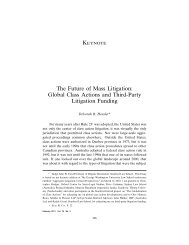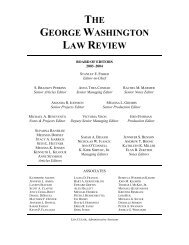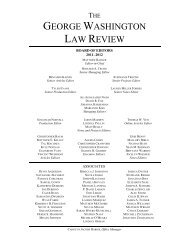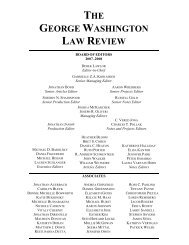View PDF - The George Washington Law Review
View PDF - The George Washington Law Review
View PDF - The George Washington Law Review
You also want an ePaper? Increase the reach of your titles
YUMPU automatically turns print PDFs into web optimized ePapers that Google loves.
880 <strong>The</strong> <strong>George</strong> <strong>Washington</strong> <strong>Law</strong> <strong>Review</strong> [Vol. 78:870<br />
B. A Deeper Reading of Lingle<br />
To determine Lingle’s ultimate effect on regulatory takings jurisprudence,<br />
it is necessary to peel away the layers of the Lingle holding.<br />
At first glance, Lingle appears to be an innocuous opinion making a<br />
minor technical correction to the law governing regulatory takings and<br />
renouncing an erroneous dictum. 61 Justice O’Connor bluntly acknowledged<br />
that the Court had confused due process and takings law<br />
in Agins and wrote that, “[o]n occasion, a would-be doctrinal rule or<br />
test finds its way into our case law through simple repetition of a<br />
phrase—however fortuitously coined.” 62 This technical correction<br />
would appear to have a trivial impact on takings law when one considers<br />
that the courts failed “to utilize the [Agins] test to place limits on<br />
government regulation.” 63 Lingle’s voiding of the Agins test would<br />
then amount to no more than “a mere formality.” 64<br />
Further consideration reveals, however, that Lingle may sweep<br />
much more broadly. Justice O’Connor noted that a regulatory takings<br />
test “focuses directly upon the severity of the burden that government<br />
imposes upon private property rights.” 65 Although takings jurisprudence<br />
follows this approach of determining whether a regulation’s impact<br />
is “functionally equivalent” to a direct appropriation, 66 due<br />
process analysis focuses on the legitimacy of the government’s action.<br />
For example, due process review under the rational basis standard<br />
asks whether a regulation is rationally related to a legitimate state in-<br />
61 See generally Daniel Jacobs, Indigestion from Eating Crow: <strong>The</strong> Impact of Lingle v.<br />
Chevron U.S.A., Inc. on the Future of Regulatory Takings Doctrine, 38 URB. LAW. 451 (2006)<br />
(arguing that the Court had to essentially “eat crow” when it admitted that it had mistakenly<br />
applied the “substantially advances” test to regulatory takings doctrine). It must be noted that<br />
Jacobs does entertain the possibility of “indigestion” occurring in the future and specifically<br />
mentions the heightened rational basis due process review Justice Kennedy hinted at in his concurring<br />
opinion. Id. at 486; see infra note 174 and accompanying text.<br />
62 Lingle, 544 U.S. at 531.<br />
63 Jacobs, supra note 61, at 480 n.183.<br />
64 See id. at 480–81.<br />
65 Lingle, 544 U.S. at 539.<br />
66 Id. Justice O’Connor’s reason for focusing the analysis on the regulation’s burden on<br />
property rights is clear when takings law is examined from a historical perspective. <strong>The</strong> Fifth<br />
Amendment makes no mention of regulatory takings, and, prior to Mahon, just compensation<br />
was given only in those scenarios where the government directly appropriated the land. See<br />
Lucas v. S.C. Coastal Council, 505 U.S. 1003, 1014 (1992) (noting that, prior to Mahon, “it was<br />
generally thought that the Takings Clause reached only a ‘direct appropriation’ of property . . .<br />
or the functional equivalent of a ‘practical ouster of [the owner’s] possession’”) (citations<br />
omitted).



